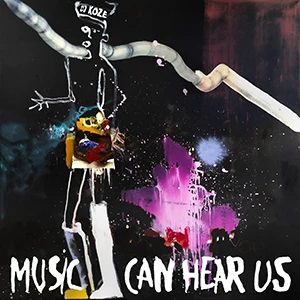
Listening to DJ Koze’s Music Can Hear Us is like stepping into a kooky sonic funhouse — playfully warped, pleasantly disorienting, and strangely familiar.
 Music Can Hear Us DJ Koze Pampa 4 April 2025
Music Can Hear Us DJ Koze Pampa 4 April 2025
What’s that you hear? A dental drill? Is that Vocaloid Damon Albarn giggling? Is this vibe heading towards “Woody Woodpecker” or an “ayahuasca retreat?” But most often, you’ll ask: Have I heard this sample before? Maybe you have, perhaps you haven’t, but that’s beside the point. DJ Koze thrives on a sense of déjà vu, reshaping sound fragments, reversing melodies, warping tempos, and layering unexpected textures to create something new.
Across 64 minutes, he challenges every preconception about what should sound good. Think nu-metal is dumb? Then why is “Brushcutter” (featuring Marley Waters) so fun in all its gritty, neon-colored glory? Do you think “Chipmunk Soul” is played out? Then why do the spiraling, sped-up vocal swirls of “Wie schön du bist” (featuring Arnim Teutoburg-Weiss and the Düsseldorf Düsterboys) hit so close to the heart?

Even the album’s opening—a quote from Rumi’s A Great Wagon about meeting “beyond good and bad” in a field—initially feels like an eye-roll. However, after a few listens, it sneaks up on you. DJ Koze‘s mission is clear: beyond the limits of genre, convention, or expectation, Music Can Hear Us exists, and he’s waiting for you to meet him there.
He keeps listeners grounded with a deep, tactile sense of rhythm, scattering percussive textures like breadcrumbs through his dense, psychedelic labyrinth. Even when dissonant strings screech overhead or eerie reversed vocals swoop by, there’s always a solid groove to clutch beneath it all.
However, we all know the kind of reputation breadcrumb trails have, tasty as they may be. Losing your way is bound to happen, but it may be part of the experience, at least once you’re past the snotty-nose-crying-into-the-camera part, a la Blair Witch Project. The first listen can feel overwhelming, as though you’ve stumbled, wide-eyed, into the yawning, spooky sonic wilderness with no map—unsure what to listen for or if it’s not very chill to ask yourself that question to begin with. But with time, the record reveals itself, its once-daunting terrain becoming familiar, navigable, and even irresistible.
DJ Koze’s world is one of contradictions—synthetic yet deeply human, playful yet profound. “Pure Love” (featuring Albarn) teeters and gives us a nearly stifled giggle over a woozy, Thundercat-esque bassline. “The Talented Mr. Tripley” bends relatively conventional vocals and pop percussion into alien, liquid forms, as though submerged in a bubbling, synthetic ocean.
The album title seems to pose a silly question at first, but the deeper you listen, the more it feels like Music Can Hear Us isn’t just a name; it’s a concept with more spiritual weight than one might think. We are different people every time we listen to a particular song, and maybe that song is a little different every time we visit it, too.
Sure, that might sound like “bong philosophy”, but DJ Koze doesn’t shy away from meeting listeners wherever they are, and that’s precisely where most of us live. Like Oscar Wilde wrote in Lady Windermere’s Fan, “We are all in the gutter, but some of us are looking at the stars.”
Regardless of his audience of mere mortals, DJ Koze’s hand reaches toward those stars, the mystical—toward that field beyond illusion—while his feet stay firmly planted on the ground, anchoring the chaos with undeniable grooves. The best part of all? You can tell he’s having a lot of fun doing it.


